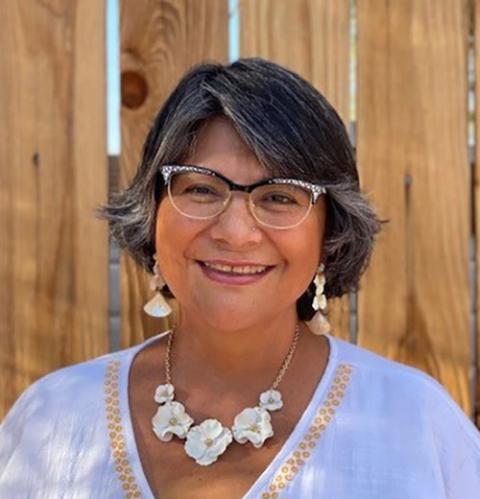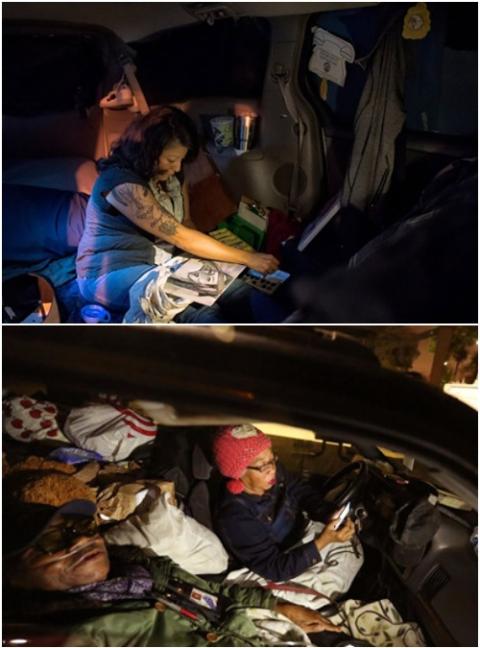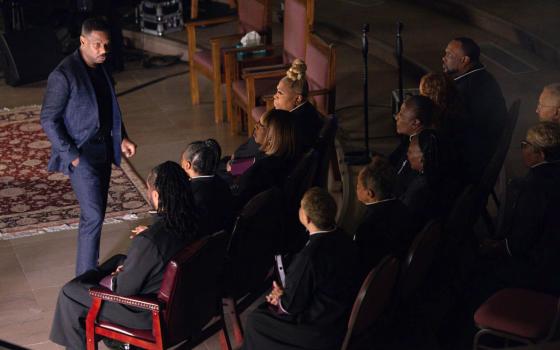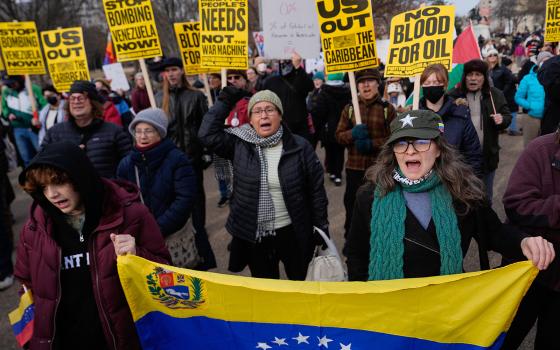For those in Los Angeles who live out of their cars, a safe parking spot where they can sleep and have access to restrooms and social services can make all the difference.
Safe Parking LA aims to convert Los Angeles County's underutilized parking lots for city residents experiencing homelessness with vehicles. Inspired by a similar program in nearby Santa Barbara called New Beginnings, Safe Parking LA began in 2016 after challenging the city's ordinances to allow people the right to sleep in their cars and park overnight in public spaces.
By 2018, the first of 10 lots for people living out of their cars was established in the Los Angeles County, and the program now serves about 400 clients a year after an application process.

Silvia Gutierrez, member of the Immaculate Heart Community and executive director of Safe Parking LA (Courtesy of Silvia Gutierrez)
"Every time we help somebody who is experiencing homelessness and get them housed, we also focus on their overall well-being — not just being housed, but becoming a productive member of society and changing the generational path of that family," said Silvia Gutierrez, the program's executive director. "It really makes me feel like I'm making a difference in society."
A member of the Immaculate Heart Community, Gutierrez, a social worker by training, previously oversaw programs for the Good Shepherd Center for homeless women and children for Catholic Charities of Los Angeles. She has also worked in domestic violence and permanent housing programs.
Safe Parking LA thrives off its partnerships with local faith communities — parishes, synagogues and faith organizations alike. (One of the parking lots, for example, is located at Beit T'Shuvah, a substance abuse recovery service in the Jewish community.)
"The Catholic faith has been at the core of who I am and my interest in serving my community, and going to Immaculate Heart just reinforced the Catholic ideas of service of caring about everyone and taking action in the world," Gutierrez said. "It's really about putting our feelings and our intentions into action."
GSR: What is the average stay for someone parking?
Gutierrez: Our average is about six to eight months that people stay with us in our parking programs.
About 75% of our clients have income when they're coming into our parking programs. When they're enrolling, they either have part-time jobs, full-time jobs, or they have unemployment benefits, Social Security, disability. And most of our clients are experiencing homelessness for the first time, so they're not chronically homeless. To be considered chronically homeless, you have to be at least two years consistently homeless and have a disabling condition.
In California, we're going on maybe our seventh year of working within the system that really looks at the characteristics of a person experiencing homelessness, and we do an assessment that looks at their health, all of the risk factors a person has. We want to prioritize housing for those most in need so we have fewer people dying on the streets that are homeless. And that is a good system.
Advertisement
However, in life, one system doesn't always fit all things, so Safe Parking LA is one of the newest strategies in the Los Angeles County area. This concept of having safe parking is new as a program, and it's really meeting an unmet need, because our clients really just need a bridge and support to pivot back into stable housing. They already have income that they're saving while they're enrolled in our program, and we have access to financial assistance, as well, to support them to pay for security deposits or the first month's rent.
They're able to quickly see their way out of the situation, and that's great because they don't need to go into the shelter system, which has you staying in a shelter for 30, 60 or 90 days.
Do you see a lot of families parking, or are they usually individuals?
This last year, we had about a dozen families that parked with us. We try to pivot families to shelters so they're not living in their vehicle, and there are a lot of resources in LA County through Homeless Family Solution Centers to have a pathway into interim housing, crisis housing shelter, so families are coming indoors.
But because the county's homeless crisis hasn't lessened in the last five years, unfortunately, the systems always have more needs than they are able to supply. We've had times where we've had families parked with us for a month or a couple of weeks or a couple of days, depending on how quickly the resources can open up to bridge families getting into crisis shelters.
Tell me about the impact of COVID-19 on the program.
When COVID first started in the beginning of 2020, Safe Parking LA saw a significant drop in our numbers, actually.
When you're living in your vehicles, it's a very exposed environment because you're not living under the safety of four walls. Whatever happens in the elements can directly impact you. It's really a raw feeling of being exposed.

According to the annual report of Safe Parking Los Angeles for the period of July 2020 to June 2021, more than one-third of their clients were over 55 years old. Women represented 36% of those who used the organization's services. (Photos courtesy of Silvia Gutierrez)
For example, in 2020, in LA County, we had a lot of riots and protests because of the Black Lives Matter movement, civil unrest that directly touched our clients in the city of LA. The mayor instituted a curfew, and that meant that our clients were exposed to the elements.—
We had to really work with all of our lot owners to open up our parking programs at 5 o'clock [which was the curfew, rather than normally opening at 7 p.m.]. We had just a couple of hours to get all this done and to communicate to our clients that they could safely return to the parking program at 5 o'clock.
We focused a lot on giving clients the education that they needed to be informed about the virus and what the risk factors were. We did a lot of screening with people during that time and were able to place a lot of people with risk factors in Project Roomkey [a state program that converted hotel rooms into emergency shelters].
We were very vigilant to stay on top of the resources so that we could utilize them. All of the Starbucks closed, for example, so our clients weren't able to access Wi-Fi. All of the gyms closed, and our clients normally use gyms to take showers. So we had to be at the forefront of getting all of the emergency resources, all of the access centers, all of the food pantries that were giving food, and find out where clients could get showers — through the YMCA, for example.
Can you tell me about a specific individual whose parking space made all the difference?
When we were putting together our end-of-the-year data, we saw we have a lot of clients who are senior citizens; people don't usually think of seniors when they think about parking programs. One of our success stories that we spotlighted was a gentleman who is 71 years old and has been experiencing homelessness off and on for the last seven years. He was struggling to recover from a divorce and several health issues, including a history of heart disease, diabetes and hearing loss. Getting back on his feet had been really challenging; the divorce really set him back.
When he enrolled in Safe Parking LA in March 2021, his life really felt messy and cluttered; he needed to have repairs done on his vehicle. We were able to help him with the immediate repairs, and we made sure he had car insurance, registration — those are all basic things that we work with all of our clients and their case managers.
He began to set small goals to take steps to get into stable housing, to make sure that he was able to collect [Social Security], to bring his vehicle into legal compliance, and to get his green card renewed. And in June, we transitioned him into a community of tiny homes in the Reseda area [for interim housing], where he'll continue working toward getting into permanent housing.
One of the things he said was that we changed his life, that if he wouldn't have gotten into the tiny homes in the summer, he felt like he was going to die in his car because he was already feeling like his life was unmanageable. And then this summer in Los Angeles, we experienced a heat wave. Pivoting him into the tiny-home community got him out of his car, got him out of the heat and continued to show him the pathway to getting out of his homeless situation.
'People have full-time jobs, doing Uber, hustling, but they still can't pay what it costs to live in a safe, nice neighborhood and rent.'
—Silvia Gutierrez of Safe Parking LA
How have these programs affected how you see homelessness as a social issue?
It's difficult and layered, but I'm not pessimistic about it because 2020 and the pandemic opened up creative solutions for ending homelessness.
On one side of things, it makes me sad that we have to have these grave, urgent, catastrophic things happen for us as a society to think outside the box and push initiatives through that create impact — for example, Project Roomkey — that never would have happened had we not had a pandemic. Our tiny-home communities that are springing up in LA County would not have been happening if it had not necessarily been for the pandemic magnifying the vulnerability of people experiencing homelessness.
When there are stay-at-home orders that are mandated by the state or federal government, you have to look at the fact that there's all these people that have no homes. And so even though we always knew that and we've been working on solving the issue of homelessness, the elements of life in the real world magnified the urgency of the need.
Since 2020, I've been able to see movement that I haven't seen in over 20 years. So that makes me hopeful and not pessimistic, but the reality is there's not enough housing in LA County to meet the need, and there's not multifaceted housing to support the complex demographics of people living in this area.
We need more low-income housing, but we also need a mixture of housing; we're not working with people who have no income or are on general relief, but sometimes you're not rich enough, and you're not poor enough to qualify for things. We have to be able to have housing that meets all of the income needs.
And then the other side of this is income: What people make is not enough to support what housing costs. In Los Angeles County, housing costs have risen year after year, but what people get paid has not. People have full-time jobs, doing Uber, hustling, but they still can't pay what it costs to live in a safe, nice neighborhood and rent.






